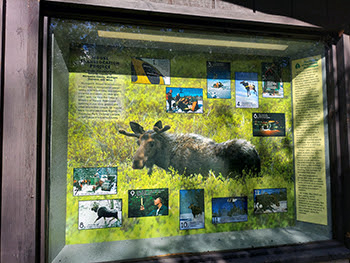Do We Need Central Command to Manage Our Moose?
By Glen Wunderlich
The Michigan Department of Natural Resources will aid the U.S. Fish and Wildlife Service in the federal agency’s evaluation of whether the northwestern subspecies of moose – found in four states including Michigan – should be added to the list of threatened and endangered species affording federal protection.
The northwestern moose subspecies (Alces alces andersoni) found in the Upper Peninsula, including Isle Royale, northeastern and northwestern Minnesota, northeastern North Dakota, as well as a small, recently established population in Wisconsin is being evaluated for Endangered Species, brought on by a petition submitted by The Center for Biological Diversity and Honor the Earth.
It’s a simple scheme: Get the animal listed for protection so that it can never be hunted, unless it is returned to all of its original territory. That’s the current position, as determined by a federal judge relative to our wolf population – even though wolves are well beyond any established recovery goals. And, if these extremists get their way, the same precedent-setting “logic” will be applied to moose.
During the subspecies status review – commonly referred to as a “12-month finding” –the Service will take a closer look at the moose subspecies population, including threats.
At this point, the Service will solicit additional scientific and commercial information from all sources to inform their decision. Ninety-day findings are published in the Federal Register and represent the Service’s first step in assessing the measures proposed in the petition.
“In Michigan, the moose population has declined for a variety of reasons, including habitat loss, predation and climate change,” Russ Mason, DNR Chief said. “Moose thrive in cold conditions due to their thick insulating fur, long legs and wide feet. Warmer temperatures put moose at risk of overheating, which causes malnutrition and immune system concerns.”
Moose are native to Michigan and occurred throughout all except the southwestern Lower Peninsula prior to European settlement. With habitat loss, hunting and brainworm, moose disappeared from the Lower Peninsula in the 1890s, and only a few scattered individuals remained in the Upper Peninsula.
In the mid-1980s, the DNR translocated 59 moose from Algonquin Provincial Park in Ontario, Canada and released them in Marquette County near Michigamme. These relocated moose increased their numbers, given improved habitat conditions with fewer white-tailed deer and poaching widely discontinued.
DNR population surveys in recent years have estimated the moose population at roughly 400 in the western U.P. and, based on citizen reports and field observations, about 100 in the eastern part of the region. Michigan Natural Resources Commission determined that current conditions of the state’s moose population did not support authorizing a hunt.
The Center for Biological Diversity (CBD) makes a living suing mainly the federal government, and then recouping those fees and more. The Obama Administration recently cut a deal with the anti-hunting activists at the CBD on accelerated Endangered Species Act (ESA) listings. Per the legal agreement, the U.S. Fish and Wildlife Service (FWS) is required to consider adding 757 species, subspecies, or distinct population segments to the list of endangered or threatened species. Decisions on all 757 must be rendered by October, 2016. The list includes species that are presently fished, hunted or trapped, including golden trout, cottontail rabbits, sage grouse, fisher, and wolverine.
The question is do we really need a judge from “Central Command” to mandate how we manage our wildlife? I think not, but it’s a moot point – for now.






